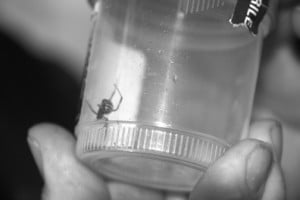
By Mary O’KEEFE
A local resident wants to warn neighbors of a new spider in town – the brown widow. La Crescenta resident Jay Eatherton had seen a news report on the brown widow spider invading California. The report noted the spider’s poisonous and painful bite. “I had heard of black widows but this was the first time we heard of a brown widow,” he said.
Shortly after seeing the report he found a brown widow on his front porch.
“I was worried because my wife is pregnant and she is really afraid of spiders,” he added. “The report said the spider’s venom was more [potent] than a black widow.”
Those stories may have been a little exaggerated, according to a response to the reports from UC Riverside Entomologist Richard Vetter on his website.
The venom’s toxicity, drop by drop, is as strong as other widow species however, according to a South African study of 15 verified bites, the brown widow victims did not show the classic signs of poisoning.
“The reason for the weaker effect of brown widow bites on humans is possibly because the brown widow does not have or cannot inject as much venom as its larger relatives,” according to Vetter’s website, cisr.ucr.edu/brown_widow_spider. However, there has been at least one report of a victim being hospitalized due to a brown widow’s bite, the website stated.
The bite is painful and will leave a red mark on the skin. Not wanting to take any chances, Jay contacted exterminator Bill Hayman.

“They are pretty common in the San Fernando [and San Gabriel] valleys,” Hayman said. “Eatherton lives next to a wash – spiders like that type of home.” Brown widows like dark, woody areas to build their homes.
“Some typical sites selected by brown widows for web building are empty containers such as buckets and nursery pots, mail boxes, entry-way corners, under eaves, storage closets and garages, recessed hand grips of plastic garbage cans, undercarriages of motor vehicles that are stationary for long periods, and the undersides of outdoor furniture and wrought iron railings. They choose places that are more exposed than sites chosen by black widows and, hence, appear to be at higher risk for interactions with humans as far as bites are concerned,” according to Vetter’s website.
As with most non-native plants and bugs, the brown widow spider migrated to the United States via imports and travelers. The spider is originally from South Africa and has been reported in several states from the east to the west coast. Unlike its relative, the black widow with its red hourglass on a black body, the brown widow is more difficult to identify. It has varied tan and brown colors accented by black markings. It, too, has an hourglass image but in orange rather than the bright red of the black widow. Young brown widows often look like their black counterparts.
“Black widows are still the most dangerous and prolific spider for residents to worry about,” Hayman said. “I see brown widows but not as much as black widows.”
The black widow’s bite itself, may be less painful than a brown but it delivers more venom which affects the nerve-muscle junction of the body. If bitten, the victim is advised to seek medical attention.
“The brown widows, like other spiders, usually won’t bite as long as you don’t mess with them,” Hayman stated.
Hayman added that brown spiders can be a little unnerving and will jump. Spiders don’t actually jump to attack people; it is usually a reaction when their web is disturbed.
Eatherton said that others may have seen the report and would be concerned if they saw the brown widow. “It is pretty creepy looking,” he added. “I just think people should know it is around and be aware.”
